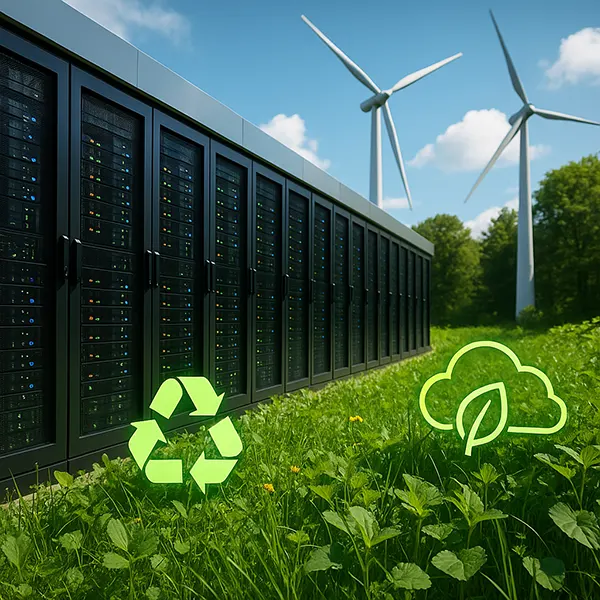
How New Eco Standards Affect Cloud Infrastructure: Green Cloud Computing Practices in 2025
As environmental concerns continue to reshape the global technology landscape, the cloud computing industry faces increasing pressure to align with sustainable development goals. In 2025, “green cloud computing” is no longer a theoretical concept but a necessary standard. With energy consumption from hyperscale data centres rising steadily, regulatory frameworks and consumer expectations are forcing providers like Google, AWS, and Microsoft Azure to adopt eco-conscious architectures. This article explores how new environmental standards are influencing cloud infrastructure and which practical tools and practices are leading this transformation.
Carbon-Aware Workloads: Adapting Cloud Computing to the Climate Crisis
In 2025, one of the most transformative shifts in cloud strategy involves the implementation of carbon-aware workloads. These workloads dynamically adjust computing operations based on the availability of renewable energy, carbon intensity of power grids, and real-time environmental data. By scheduling tasks during periods of low carbon intensity or in regions with greener grids, major cloud providers are actively reducing their environmental impact.
Google Cloud’s “Carbon-Aware Computing” initiative has expanded globally, integrating data from electricityMap and WattTime. Users can now configure their virtual machines to prefer times and locations with cleaner energy. Meanwhile, Microsoft Azure offers tools that analyse workload impact and suggest migration patterns optimised for carbon efficiency.
AWS has introduced sustainability dashboards that not only report energy usage but offer proactive recommendations for minimising carbon emissions. Combined with AI-driven resource scheduling, these dashboards are helping organisations integrate sustainability into daily operations.
How Major Providers Integrate Carbon Awareness
Google’s cloud workloads are managed with the help of predictive models that consider regional energy mix forecasts. These models enable automated task allocation to green-friendly zones. Azure supports “Emissions Impact Dashboards” allowing companies to visualise emissions per workload and shift processes accordingly.
AWS users benefit from the Cloud Intelligence Dashboards, which present granular sustainability metrics by account, service, and region. These tools support compliance with evolving climate disclosure mandates such as the Corporate Sustainability Reporting Directive (CSRD) in the EU.
The combined effect is a new industry norm—one where carbon efficiency becomes as critical a metric as latency or cost.
Measuring the Developer’s Carbon Footprint: Transparency and Responsibility
In 2025, developers are no longer disconnected from the environmental consequences of their code. With modern eco standards, software development is linked to measurable ecological metrics. Companies are adopting solutions that quantify the carbon footprint of applications during development, deployment, and operation stages.
This trend is supported by cloud-native tools that estimate emissions from resource provisioning, execution time, and idle consumption. By surfacing this data early, developers can refactor code or redesign architectures to avoid unnecessary load or poorly optimised workflows.
Beyond metrics, the inclusion of sustainability key performance indicators (KPIs) into continuous integration and deployment (CI/CD) pipelines is gaining traction. This ensures that ecological impact is evaluated alongside security and performance before software is approved for production.
Tools Empowering Developers with Carbon Metrics
Cloud Carbon Footprint (CCF), an open-source tool backed by ThoughtWorks, is now widely used by enterprises to visualise the emissions linked to their cloud services. It converts billing data into carbon equivalents, giving developers direct feedback on the impact of their decisions.
Scaphandre, another notable project, is a lightweight monitoring agent that calculates energy consumption per container, process, or VM. It supports major orchestration tools like Kubernetes, offering real-time carbon usage analytics embedded within DevOps workflows.
These tools have become essential for organisations aiming to comply with stricter environmental disclosure requirements and maintain transparent sustainability records.

Adoption in the Real World: Companies Leading Green Cloud Transformation
In 2025, numerous enterprises across sectors are committing to green cloud computing as part of their net-zero strategies. From financial services to e-commerce, these organisations are proving that sustainability and scalability can coexist in the digital realm.
For instance, Spotify has migrated a significant portion of its workloads to carbon-aware zones on Google Cloud, reducing its emissions by 35% in one year. The company also utilises Cloud Carbon Footprint to track progress and fine-tune cloud resource allocation for energy efficiency.
Meanwhile, Siemens has partnered with Microsoft to embed emissions intelligence into industrial cloud systems. This integration supports real-time visibility into emissions from factory-floor analytics, IoT workloads, and digital twins—driving both energy savings and compliance.
Success Stories from Industry Leaders
German fintech N26 uses AWS sustainability dashboards to enforce internal environmental KPIs for all cloud-based operations. Their CI/CD policies require emission audits before major code deployments. This alignment of cloud governance with ESG targets has won praise from EU regulators.
French IT services firm Capgemini has built sustainability into its managed cloud services. Using Scaphandre and CCF across all client deployments, Capgemini provides carbon accounting by project, making sustainability an integral part of service-level agreements.
These cases illustrate how early investment in green cloud strategies yields long-term value—not just in cost or compliance, but in corporate reputation and environmental stewardship.





